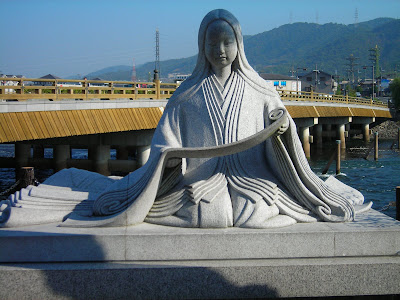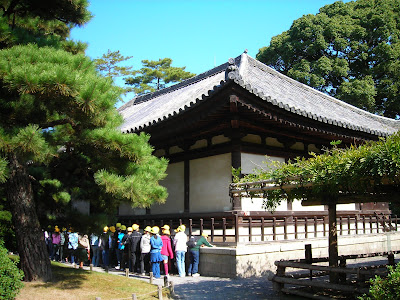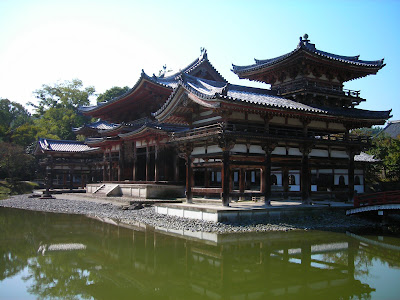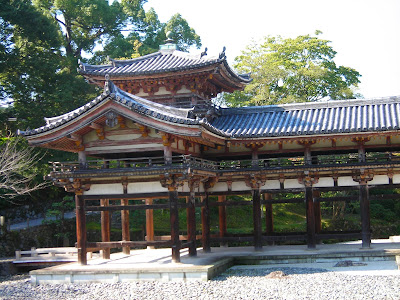Byodo-in
On day 5--which I believe was actually day 4, but never mind that--I decided to get out of Kyoto. It was gorgeous, perfect weather once again, and I woke up nice and early to make the trip to two sights I'd really been looking forward to seeing. They were on the same train line, IIRC. The first place is called Byodo-in. I've really wanted to see it ever since I first learned about it in class--it's really, really beautiful. It's also one of the few remaining Heian-period structures left in Japan (I think the only one, actually), and the Heian period is just a ridiculously romantic era.
So I set off for Uji, which is a small town a little ways outside of Kyoto. It is also somewhat famous for being a major location in the classic Japanese masterpiece, "The Tale of Genji." So when I was walking to Byodo-in, nice and bright and early, I saw this lovely statue and a plaque beside the river! The plaque was in Japanese, I think, but I can recognize a Heian-era lady when I see one. This statue represents Lady Murasaki, who wrote "The Tale of Genji." I doubt it's particularly ancient or anything, but I really liked it. It also has Uji Bridge in the background. Uji River was very important because it was the site of many battles.
So I set off for Uji, which is a small town a little ways outside of Kyoto. It is also somewhat famous for being a major location in the classic Japanese masterpiece, "The Tale of Genji." So when I was walking to Byodo-in, nice and bright and early, I saw this lovely statue and a plaque beside the river! The plaque was in Japanese, I think, but I can recognize a Heian-era lady when I see one. This statue represents Lady Murasaki, who wrote "The Tale of Genji." I doubt it's particularly ancient or anything, but I really liked it. It also has Uji Bridge in the background. Uji River was very important because it was the site of many battles.

Anyways, I eventually arrived at Byodo-in right as it was opening. It was quite nice and fairly uncrowded at that point. When I got in, the first tour of the day was starting--the temple was raising funds to restore the main Buddha image, which is inside the Phoenix Hall, and because of this, they were selling special tickets for some extra cash, for which you could actually go inside and check it all out. Of course, I bought the tickets. Not only is the Buddha very cool, but there are some really ancient paintings inside--very famous, especially if you're an art history major. It was amazing seeing them in real life, although they were quite hard to see! But still, definitely worth it.
Anways, the main building at the Byodo-in temple, the Phoenix Hall, was actually built in the early 11th century. It's almost 900 years old, and somehow managed to survive all these years. Everything else around it was burnt down at some point, but the hall survived. Now there's pretty much nothing there except this pond (man-made) and the hall itself. It is an incredibly graceful structure. Some people say that it's known as the Phoenix Hall not because of the bird statues on its roof, but because it looks like a phoenix, wings spread, elegant and symmetrical in the midst of a famously reflective pond.
The building was originally not a temple, but a pleasure-villa, built to resemble the Pure Land paradise. The pond surrounds it, and is probably one of the reason it has survived for so long.
It's hard to make out in this shot, but the central Kannon image can sometimes be seen in the reflection, because it's so perfect. It makes it seem like it is "floating."
One of the things I really liked about Byodo-in is that you can see how old it is. It's not restored and prettified to an uncomfortable degree, like many locations in Japan. It's weathered, but well preserved. You can see the paint flaking and degrading (although it's not the original paint, of course.) But every little element is just so graceful, so elegant, so perfectly imagined. I really loved it.

As you can see, Byodo-in is a very well known locale in Japan. It's featured on the back of the 10 yen coin--that's how important it is. Loads of school children began to arrive shortly after the temple opened up for business. These elementary school kids all wear hats so they can be easily recognized (and, I presume, avoided.) They are standing near the Kannondo, a later structure built to house some images. There is also a shiny new museum there, detailing the restoration process and showing some various images. It's very classy.
I lingered here as long as I could, but eventually I had to move on. My day was not over yet!
I lingered here as long as I could, but eventually I had to move on. My day was not over yet!



No comments:
Post a Comment